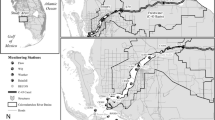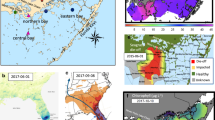Abstract
Florida Bay is more saline than it was historically, and reduced freshwater flows may lead to more phosphorus inputs to the mangrove ecotone from the marine end-member. This is important given plans to restore freshwater flow into eastern Florida Bay. We investigated the relationships between salinity, nutrients, and hydrologic variables in the mangrove ecotone of Taylor Slough. We expected that total phosphorus (TP) would increase with salinity, reflecting a downstream marine source, while total nitrogen (TN) would increase with flow in the mangrove ecotone. Despite expectations of increased flows improving the ecological health of lower Taylor Slough and Florida Bay, total nitrogen (TN) and total phosphorus (TP) dynamics may shift in response to new conditions of flow and salinity as well as organic carbon, N, and P availability. Our results showed that TP concentrations are more discharge-driven while TN is more variable and potentially derived from different sources along the flow path from the freshwater Everglades marshes to Florida Bay. Increased flow of freshwater through Taylor Slough will likely decrease TP concentrations in this historically oligotrophic and P-limited ecosystem. However, more studies along the mangrove ecotone is needed to understand how increased flows will affect nitrogen dynamics relative to phosphorus.




Similar content being viewed by others
References
Adrian R, Wilhelm S, Gerten D (2006) Life-history traits of lake plankton species may govern their phenological response to climate warming. Global Change Biology 12:652–661
Brand LE (2001) The transport of terrestrial nutrients to South Florida coastal waters. In: Porter JW, Porter KG (eds) The Everglades, Florida Bay, and coral reefs of the Florida Keys: an ecosystem sourcebook. CRC Press, Boca Raton, pp 361–413
Briceño HO, Boyer JN (2010) Climatic controls on phytoplankton biomass in a sub-tropical estuary, Florida Bay, USA. Estuaries and Coasts 33:541–553. doi:10.1007/s12237-009-9189-1
Castañeda-Moya E, Twilley RR, Rivera-Monroy VH, Zhang K, Davis SE, Ross M (2010) Sediment and nutrient deposition associated with Hurricane Wilma in mangroves of the Florida coastal Everglades. Estuaries and Coasts 33:45–58
Childers DL, Day JW Jr, Muller RL (1990) Relating climatological forcing to coastal water levels in Louisiana estuaries and the potential importance of El Niño-Southern Oscillation events. Climate Research 1:31–42
Childers DL, Jones RD, Trexler JC, Buzzelli C, Dailey S, Edwards AL, Gaiser EE, Jayachandaran K, Kenne A, Lee D, Meeder JF, Pechmann JHK, Renshaw A, Richards J, Rugge M, Scinto IJ, Sterling P, Gelder WV (2001) Quantifying the effects of low-level phosphorus additions on unenriched Everglades wetlands with in situ flumes and phosphorus dosing. In: Porter JW, Porter KG (eds) The Everglades, Florida Bay, and coral reefs of the Florida Keys: an ecosystem sourcebook. CRC Press, Boca Raton, pp 127–152
Childers DL, Boyer JN, Davis SE III, Madden CJ, Rudnick DT, Sklar FH (2006) Relating precipitation and water management to nutrient concentrations in the oligotrophic “upside-down” estuaries of the Florida Everglades. Limnology and Oceanography 51:602–616
Clark JS, Carpenter SR, Barber M, Collins S, Dobson A, Foley J, Lodge DM, Pascual M, Pielke R, Pizer W, Pringle C, Reid WV, Rose KA, Sala O, Schlesinger WH, Wall DH, Wear D (2001) Ecological forecasts: an emerging imperative. Science 293:657–660
Davis SM (1994) Phosphorus inputs and vegetation sensitivity in the Everglades. In: Davis SM, Ogden JC (eds) Everglades: the ecosystem and its restoration. St. Lucie Press, Delray Beach, pp 357–378
Davis SE, Childers DL (2007) Importance of water source in controlling leaf leaching losses in a dwarf red mangrove (Rhizophora mangle L.) wetland. Estuarine, Coastal and Shelf Science 71(1–2):194–201
Davis SE, Childers DL, Day JW, Rudnick DT, Sklar FH (2003) Factors affecting the concentration and flux of materials in two southern Everglades mangrove wetlands. Marine Ecology Progress Series 253:85–96
Davis SE, Cable J, Childers C, Coronado C, Day JW, Hittle C, Madden C, Reyes E, Rudnick DT, Sklar FH (2004) Importance of episodic storm events in controlling ecosystem structure and function in a Gulf Coast estuary. Journal of Coastal Research 20(4):1198–1208
Duncan AJ (1974) Quality control and industrial statistics. Richard D. Irwin, Homewood
Durako MJ, Hall MO, Merell M (2001) Patterns of change in the seagrass dominated Florida Bay hydroscape. In: Porter JW, Porter KG (eds) The Everglades, Florida Bay, and coral reefs of the Florida Keys: an ecosystem sourcebook. CRC Press, Boca Raton, pp 523–537
Ewan WD (1963) When and how to use Cu-sumcharts. Technometrics 5:1–32
Eyre BD, Balls P (1999) A comparative study of nutrient behavior along the salinity gradient of tropical and temperate estuaries. Estuaries 22:313–326
Frankovich TA, Jones RD (1998) A rapid, precise, and sensitive method for the determination of total nitrogen in natural waters. Marine Chemistry 60:227–234
Gaiser EE, Scinto IJ, Richards JH, Jayachandran K, Childers DL, Trexler JC, Jones RD (2004) Phosphorus in periphyton mats provides the best metric for detecting low-level P enrichment in an oligotrophic wetland. Water Resources Research 38:507–516
Grant EL, Leavenworth RS (1980) Statistical quality control, 5th edn. McGraw-Hill, New York
Green TW, Slone DH, Swain ED, Cherkiss MS, Lohmann M, Mazzotti FJ, Rice KG (2001) Spatial and stage-structured population model of the American Crocodile for comparison of comprehensive Everglades restoration plan (CERP) alternatives. U.S. Geological Survey Open-File Report 2010-1284, 57 p
Herbert DA, Fourqurean JW (2008) Ecosystem structure and function still altered two decades after short-term fertilization of a seagrass meadow. Ecosystems 11:688–700
Ibanez F, Fromentin JM, Castel J (1993) Application of the cumulated function to the processing of chronological data in oceanography. Comptes rendus de l’Acade´mie des Sciences, Serie 3(318):745–748
Lapointe BE, Matzie WR, Barile PJ (2001) Biotic phase-shifts in Florida Bay and fore reef communities of the Florida Keys: linkages with historical freshwater flows and nitrogen loading from Everglades runoff. In: Porter JW, Porter KG (eds) The Everglades, Florida Bay, and coral reefs of the Florida Keys: an ecosystem sourcebook. CRC Press, Boca Raton, pp 629–648
Light SS, Dineen JW (1994) Water control in the Everglades: a historical perspective. In: Davis SM, Ogden JC (eds) Everglades: the ecosystem and its restoration. St. Lucie Press, Delray Beach, pp 47–84
Liu KJ, Li HP, Davis SE (in press) Benthic exchange of C, N, and P along the estuarine ecotone of lower Taylor Slough, Florida (USA): Effect of seasonal flows and phosphorus availability. Wetlands
Lorenz JJ (1999) The response of fishes to physicochemical changes in the mangroves of Northeast Florida Bay. Estuaries 22:500–517
Manly BFJ, Mackenzie D (2000) A cumulative sum type of method for environmental monitoring. Environmetrics 11:151–166
Marshall FE, Wingard GL, Pitts P (2009) A simulation of historic hydrology and salinity in Everglades National Park: coupling paleoecologic assemblage data with regression models. Estuaries and Coasts 32:37–53
Marshall FE, Smith DT, Nickerson DM (2011) Empirical tools for simulating salinity in the estuaries in Everglades National Park, Florida. Estuarine, Coastal and Shelf Science 95:377–387
McCormick PV, Rawlik PS, Lurding K, Smith EP, Sklar FH (1996) Periphyton-water quality relationships along a nutrient gradient in the Northern Florida Everglades. Journal of the North American Benthological Society 15:433–449
McIvor CC, Ley JA, Bjork RD (1994) Changes in freshwater inflow from the Everglades to Florida Bay including effects on biota and biotic processes: a review. In: Davis SM, Ogden JC (eds) Everglades: the ecosystem and its restoration. St. Lucie Press, Delray Beach, pp 117–146
Mitsch WJ, Gosselink JG (2007) Wetlands, 4th edn. Wiley, New York
Molinero JC, Ibanez F, Souissi S, Buecher E, Dallot S, Nival P (2008) Climate control on the long-term anomalous changes of zooplankton communities in the Northwestern Mediterranean. Global Change Biology 14:11–26
Montgomery DC (2001) Introduction to statistical quality control, 3rd edn. Wiley, New York
Noe GB, Childers DL, Edwards AL, Gaiser E, Jayachandran K, Lee D, Meeder J, Richards J, Scinto LJ, Trexler JC, Jones RD (2003) Short-term changes in phosphorus storage in an oligotrophic Everglades wetland ecosystem receiving experimental nutrient enrichment. Biogeochemistry 59:239–267
Ogden JS, Davis S, Jacobs KJ, Barnes T, Fling H (2005) The use of conceptual ecological models to guide ecosystem restoration in South Florida. Wetlands 25(4):795–809
Paerl HW, Valdes LM, Peierls BL, Adolf JE, Harding LW (2006) Anthropogenic and climatic influences on the eutrophication of large estuarine ecosystems. Limnology and Oceanography 51:448–462
Price RM, Swart PK, Fourqurean JW (2006) Coastal groundwater discharge – an additional source of phosphorus for the oligotrophic wetlands of the Everglades. Hydrobiologia 569:23–36
Rivera-Monroy VH, Twilley RR, Davis SE III, Childers DL, SM Chambers R, Jaffe R, Boyer JN, Rudnick DT, Zhang K, Castañeda-Moya E, Ewe SML, Price RM, Coronado-Molina CR, Ross M, Smith TJ III, Michot B, Meselhe E, Nuttle W, Troxler TG, Noe GB (2011) The role of Everglades Mangrove Ecotone Region (EMER) in regulating nutrient cycling and wetland productivity in south Florida. Critical Reviews in Environmental Science and Technology 41(6):633–669
Robblee MB, Barber TR, Carlson PR, Durako MJ, Fourqurean JW, Muehlstein LK, Porter D, Yarbro LA, Zieman RT, Zieman JC (1991) Mass mortality of the tropical seagrass Thalassia testudinum in Florida Bay (USA). Marine Ecology Progress Series 71:297–299
Ross MS, Gaiser EE, Meeder JF, Lewin MT (2001) Multi-taxon analysis of the “White Zone”, a common ecotonal feature of South Florida coastal wetlands. In: Porter JW, Porter KG (eds) The Everglades, Florida Bay, and coral reefs of the Florida Keys: an ecosystem sourcebook. CRC Press, Boca Raton, pp 205–238
Rudnick DT, Chen Z, Childers DL, Boyer JN, Fontaine TD III (1999) Phosphorus and nitrogen inputs to Florida Bay: the importance of the Everglades watershed. Estuaries 22:398–416
Sklar F, McVoy C, Vanzee D, Gawlik E, Tarboton K, Rudnick D, Miao S (2001) The effects of altered hydrology on the ecology of the Everglades. In: Porter JW, Porter KG (eds) The Everglades, Florida Bay, and coral reefs of the Florida Keys: an ecosystem sourcebook. CRC Press, Boca Raton, pp 39–82
Solórzano L, Sharp JH (1980) Determination of total dissolved phosphorus and particulate phosphorus in natural waters. Limnology and Oceanography 25:754–758
Stow CA, Roessler C, Borsuk ME, Bowen JD, Reckhow KH (2003) Comparison of estuarine water quality models for total maximum daily load development in Neuse River Estuary. Journal of Water Resources Planning and Management 129:307–314
Sutula MA, Perez BC, Reyes E, Childers DL, Davis S, Day JW Jr, Rudnick D, Sklar F (2003) Factors affecting spatial and temporal variability in material exchange between the southern Everglades wetlands and Florida Bay (USA). Estuarine, Coastal and Shelf Science 57:757–781
USACE (2011) Central and southern Florida project comprehensive Everglades restoration plan C-111 spreader canal western project: final integrated project implementation report and environmental impact statement
Wachnicka A, Gaiser E, Wingard I, Briceño H, Harlem P (2013) Impact of late Holocene climate variability and anthropogenic activities on Biscayne Bay (Florida, U.S.A.): evidence from diatoms. Palaeogeography, Palaeoclimatology, Palaeoecology 371:80–92
Woods J, Zucker M (2007) Estuarine response in northeastern Florida Bay to major hurricanes in 2005. In: Farris et al (eds) Science and the storms: the USGS response to the hurricanes of 2005, USGS Circular 1306:184–191
Acknowledgments
The authors thank the National Fish and Wildlife Foundation (grant # 9934.12.029268) and the Florida Coastal Everglades Long-Term Ecological Research program (National Science Foundation cooperative agreements #DEB-1237517 and DBI-0620409) for their support of this research. The Everglades Foundation provided internship support for G. Miller’s work on this study. This is contribution #608 from the Southeast Environmental Research Center at Florida International University.
Author information
Authors and Affiliations
Corresponding author
Rights and permissions
About this article
Cite this article
Briceño, H., Miller, G. & Davis, S.E. Relating Freshwater Flow with Estuarine Water Quality in the Southern Everglades Mangrove Ecotone. Wetlands 34 (Suppl 1), 101–111 (2014). https://doi.org/10.1007/s13157-013-0430-0
Received:
Accepted:
Published:
Issue Date:
DOI: https://doi.org/10.1007/s13157-013-0430-0




